Minister of Agriculture Carola Schouten wrote a letter to Parliament informing them of the current state of affair regarding the proposed legislation on High-Risk Dogs on 9 November 2018.
OhMyDog! has studied the document and is summarising it for you below.
In short:
- The municipalities, the police and the government will collaborate to tackle the issues on this dossier.
- Minister Schouten has requested the development of a scientifically validated risk assessment test. This tool will be used in the following situations, among others:
- To possibly exclude individual dogs from the gene pool (through castration/sterilisation);
- To request individual dogs are tested (compulsory) where justified. For example, upon the new arrival of a dog at an address falling within the municipality concerned. This test will be used by municipalities to establish whether the animal presents a high risk.
- Clarification: The need for a compulsory test will not determined by breed, but by the risk factors presented by the individual dog-owner combination (see Dogzine).
- The Minister has also tasked the CCV (Centrum voor Criminaliteitspreventie en Veiligheid) with writing an evidence-report on the risk factors and risk moments with dogs in everyday life.
- Prior to basing new pieces of legislation on a list of dog breeds, the Minister has also requested the production of a scienfically constructed list of high-risk breeds. This list should be published at the end of 2018. Clarification: The list will be updated in the future, to correspond to the latest bite incident figures gathered through the bite register system (see Dogzine).
- The police and a number of municipalities will implement a pilot for a national, uniform, bite register (TRIAS) at the start of 2019.
- Carola Schouten is weighing up the possibility of setting up a DNA data bank, but the goals of the data bank are not specified.
- The Minister has also requested a research study on socialisation within the various phases of a dog’s life.
- A compulsory course (private or group) for High-Risk Dog owners would be implemented from 2018, but Minister Schouten is only aiming at defining the course curriculum by the end of 2018. Clarification: The legal obligation to follow this course will not be based on breed, but on individual dog-owner combinations (see Dogzine).
- “Learning packets” (leerpakketten) are being developed and experts are being consulted in order to expand the knowledge of the relevant police and municipality employees about dog behaviour and risk evaluations.
Summary
In short, the aims are to:
1. Have possible future legislation on High-Risk Dogs be based on scientific research.
2. To expand the knowledge of not only the police and municipality clerks, but also of the dogs’ owners.
3. She will not only focus on reactive, after-an-incident, legislation; but also on prevention (e.g. pre-emptive behaviour tests).
4. The question of whether legislation based on a list of breeds is legally sound is central, and is being investigated.
In even fewer words: nothing is definite yet!
Referenties
- Schouten, 11 november 2018: Kamerbrief
- Overheid: Lijst van Hoog Risico Honden
- DogZine, 14 november 2018 – Meer uitleg Hoogrisicohonden brief van de Tweede Kamer
Foto’s
Staffordshire Bull Terrier – Downloaded on 9 November 2018 from Pixabay. With thanks to K9arteu. License: CC0.

